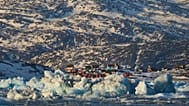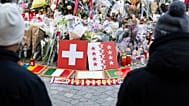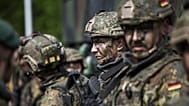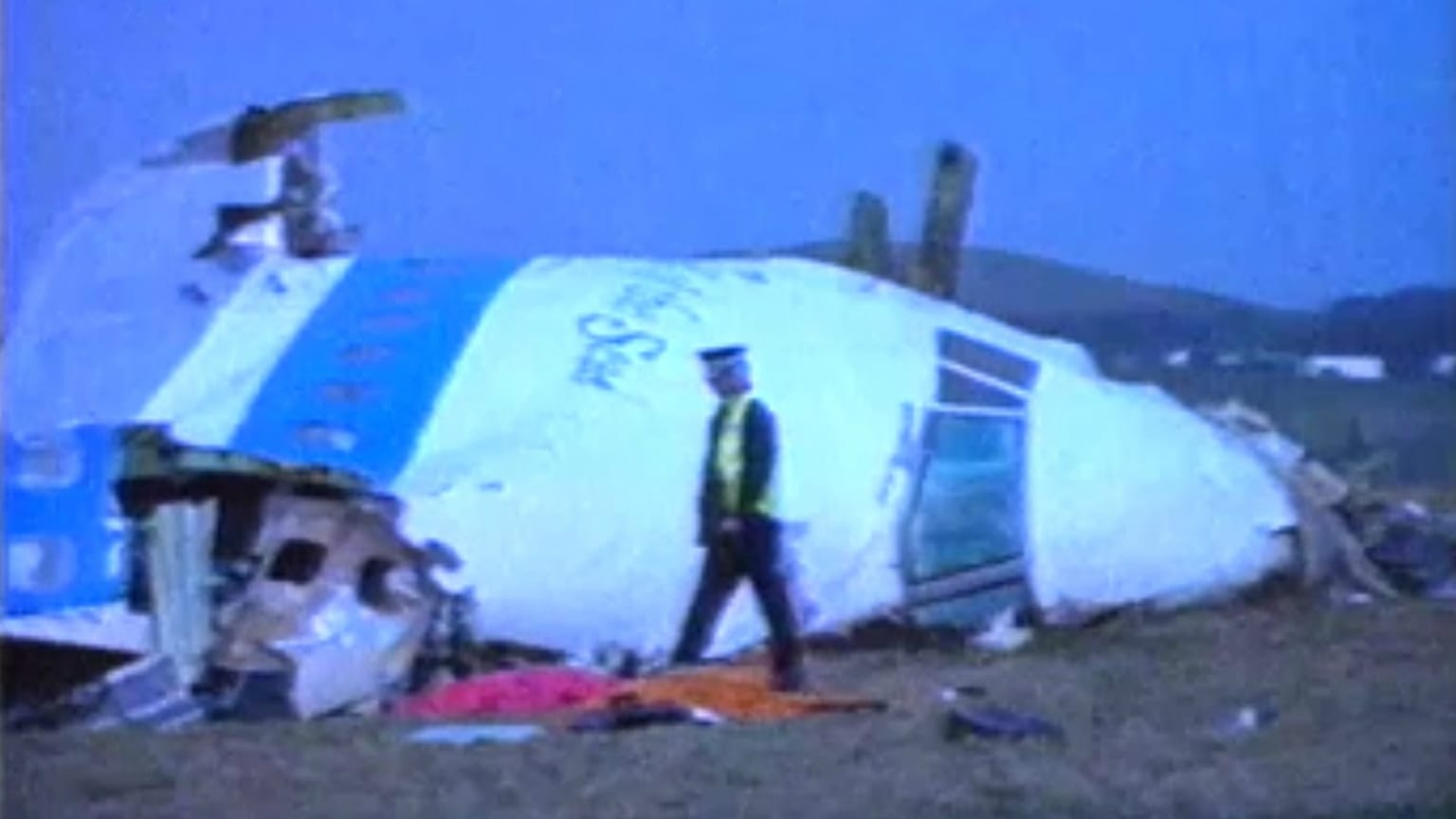Lockerbie bombing: “What really brought it home was when you were picking up toys.” On the 30th anniversary of the Lockerbie disaster, Euronews interviews a police officer drafted in to help with the aftermath and subsequent investigation.
On Wednesday 21 December, 1988, just after 7pm, Pan Am Flight 103 from London to New York exploded above the small Scottish town of Lockerbie, killing all 259 people on board and 11 people on the ground, when the wing section of the plane, carrying more than 90,000 kilos of jet fuel, hurtled from 31,000 feet into a row of houses.
Debris from the plane, which broke into five parts when the bomb inside a suitcase in its luggage hold detonated, was scattered for miles. The wing section gouged a crater where three houses had stood when it landed on Lockerbie's Sherwood Crescent, igniting a massive blaze. The rear fuselage landed on nearby Rosebank Crescent, while the nose cone came down three miles east of the town in a field at Tundergarth.
The occupants of the flight deck and several First Class passengers were found still strapped to their seats inside the nose cone when it crashed in Tundergarth, and the inquest heard that a flight attendant was found alive by a farmer's wife, but died before help could be summoned. Of the passengers, 35 were students from Syracuse University in upstate New York, returning home for Christmas after a semester studying abroad, and at least four were US government officials, giving rise to conspiracy theories that they were the intended targets.
Investigation and responsibility
Following a three-year investigation by Dumfries and Galloway Constabulary and the FBI, arrest warrants were issued for Libyan intelligence officers Abdelbaset Ali al-Megrahi and Al Amin Khalifa Fhimah, in November 1991. In 1999, Libyan leader Muammar Gaddafi handed over the two men for trial at Camp Zeist, a Scottish court set up in the Netherlands, following UN sanctions. In 2001, al-Megrahi was jailed for life after being found guilty of 270 counts of murder, while Fhimah was acquitted.
In 2003, Gaddafi accepted responsibility for the bombing and paid compensation to the victims' relatives, although he denied ordering the attack.
In 2009, al-Megrahi was released by the Scottish Government on compassionate grounds after he was diagnosed with terminal prostate cancer – a controversial move which divided the UK and US public, press and politicians alike, and drew both condemnation and approval from the families of the victims and the people of Lockerbie, many of whom had always believed him to be innocent. Al-Megrahi died at home in Libya in 2012. The Lockerbie bombing remains the UK's worst terrorist attack.
How Lockerbie's emergency services responded
The population of Lockerbie, 20 miles from the border with England in the largely rural county of Dumfries and Galloway, swelled overnight, as police, the army, firefighters, rescue workers and the international media descended – as did medics, who quickly found they were not needed. Ambulances that had been sent from around the country lined the main street, idle, surplus to requirement, with no one left to save. The victims, both in the plane and the houses below, had been killed instantly.
Under the jurisdiction of what was at the time the smallest police force in Great Britain, the town was served by 21 police officers. By the morning after the disaster, there were 1,043, with officers from neighbouring Strathclyde and Lothian and Borders Police forces, and later from across the country, bussed in.
"There was debris all over the place"
Retired police officer David Nelson, 55, from Edinburgh, was one of them – then a 25-year-old Police Constable with Lothian and Borders Police (now part of Police Scotland, the country's single force).
“I was 25, a young lad really, with a young family, and obviously you're thinking about terrorism, and if it can happen there can it happen anywhere else? With the IRA bombings, you always associated that with England, you never, ever associated any terrorism with Scotland. And even though it was quite a few miles away it still brought it home. There was no indication straight away it was terrorism, initially they were looking at an accident. But the talk with us all in the police, with everything you're hearing, was no, this is more like a bomb.”
Nelson and his colleagues knew nothing of what awaited them when they set off for Lockerbie: “We met at the police station at 4 o'clock in the morning to drive down there, it's about a two-and-a-half hour drive from Edinburgh. Pitch black, middle of winter. I always remember in the van going down it was just so quiet.
“You knew people had died on the plane so you were thinking what are we going to be doing when we get down there? We had no idea what to expect. How could you? The first day, we drove past and saw the crater and we were taken up to see the nose cone. It was eerie. It was still dark in the morning, even though we left at 4am, it was still so dark when we arrived. But you could see there was debris all over the place. It was kind of like a ghost town as well. I don't know whether this is because we arrived early in the morning or the time of the year or if folk were just staying in the house, not knowing what to do.”
Returning possessions to victims' families
With the wreckage eventually found to have had a radius of hundreds of miles, Nelson and his colleagues were dispatched to the fields and hills around Lockerbie to recover debris from the plane.
He recalls: “My first duties were going out and searching fields for bodies, body parts and luggage. And also to provide protection of them, because, it sounds horrible, but you always get your trophy hunters. Folk either out with cameras trying to take photographs or just getting trophies – 'I've got a rucksack that came out the Pan Am plane'. So you might be searching a huge field but you would also have police guarding the field as well.”
The possessions of the passengers of Flight 103 were returned to their families, in an operation which inspired the FBI to set up its own dedicated unit to return the belongings of the victims of terror attacks, and one which was in no small part down to the dedication of the so-called “Ladies of Lockerbie” – who set up a laundry in the town to wash the clothes that had tumbled from suitcases and return them clean, pressed and wrapped in tissue with handwritten notes to the families of their owners.
"What really brought it home was when you were picking up toys..."
Nelson continues: “We were finding things both for evidence and to be returned. Once they actually established it had been a bomb, any fragment, no matter how small, was evidence, even a shard. What really brought it home though was when you were picking up toys, dolls, kids' rucksacks. It was rucksacks, jackets, clothes...
“I wasn't involved with any body parts. I know a lot of friends who were. Initially they weren't looking at a bomb so to preserve the body parts they were coated in formaldehyde, but when they realised it was a bomb, all body parts had to be X-rayed, and apparently you can't X-ray through formaldehyde. So the body parts had to be washed. And a lot of police officers, with no training or anything, had to do that. And it sounds horrible, but you do have to just switch off. If you don't, you can't cope, you can't do it. There was no health and safety back then either. You just got stuck in. And I would like to think if it happened again it would all go out the window again.”
How did the disaster effect emergency workers?
Recalling the effect the disaster had on his police colleagues and fellow emergency services workers, he adds: “I was lucky, that I didn't find body parts. I certainly know some police officers who did and they were affected. Counselling was offered – but not like now, back then it just wasn't something you thought about at the time.
“In the first few days, in the vans going down there, we were silent. And coming back most people were sleeping. Then after that you began getting the stories – you'll not believe what I had to do today, or you'll not believe what I found today... and I think maybe that, by being able to tell it to your colleagues, we were kind of counselling each other. The last thing you wanted to do was go home to your wife, your kids and say oh, you'll never believe what happened today. And to be honest I can't remember discussing it a lot with my wife. You just got on with it.
“If you ask police officers to do something there'll often be a bit of a moan, but there was none of that at Lockerbie. If someone said to you right, I need you to stand at the corner of this field for the next ten hours – yeah, not a problem. You did it. You're looking at what's happened to all the passengers, what's happened to the town of Lockerbie itself....
Remembering on the 30th anniversary
The arrival of the 30th anniversary of the disaster feels of little relevance to Nelson.
“It never goes away. And even now, young cops will say oh, were you at Lockerbie. The 20th anniversary, 25th anniversary, 30th anniversary... and it's so close to Christmas, so you always remember. You see it on the TV but I don't pay a great deal of attention when I do – you know you were there, you don't need to see it on the news. This is probably the most I've ever spoken about it in thirty years.
“It sounds horrible, there's never a good time of year for a major disaster, but I suppose Christmas is even worse, and you were thinking about the children. And I can't remember seeing any children. That's what stands out when I look back. I don't know where they were, if they were being kept inside maybe... I think if I had been a parent down there I wouldn't want my children to go out because what are they going to find? Can you imagine an 8-year-old finding a body part? So maybe the parents did keep all the children in. I never saw any children in the town.”















